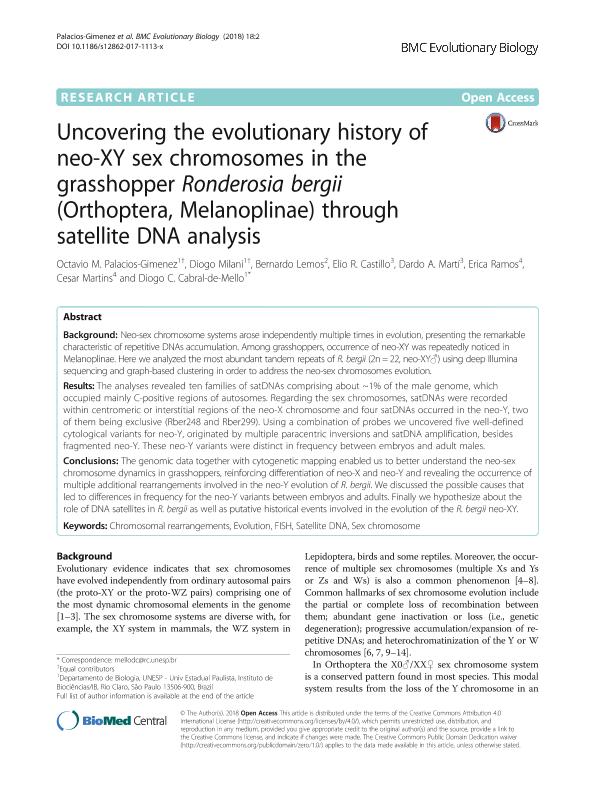Artículo
Uncovering the evolutionary history of neo-XY sex chromosomes in the grasshopper Ronderosia bergii (Orthoptera, Melanoplinae) through satellite DNA analysis
Palacios Gimenez, Octavio M.; Milani, Diogo; Lemos, Bernardo; Castillo, Elio Rodrigo Daniel ; Marti, Dardo Andrea
; Marti, Dardo Andrea ; Ramos, Erica; Cabral De Mello, Diogo C.; Martins, Cesar
; Ramos, Erica; Cabral De Mello, Diogo C.; Martins, Cesar
 ; Marti, Dardo Andrea
; Marti, Dardo Andrea ; Ramos, Erica; Cabral De Mello, Diogo C.; Martins, Cesar
; Ramos, Erica; Cabral De Mello, Diogo C.; Martins, Cesar
Fecha de publicación:
01/2018
Editorial:
BioMed Central
Revista:
BMC Evolutionary Biology
ISSN:
1471-2148
Idioma:
Inglés
Tipo de recurso:
Artículo publicado
Clasificación temática:
Resumen
Background: Neo-sex chromosome systems arose independently multiple times in evolution, presenting the remarkable characteristic of repetitive DNAs accumulation. Among grasshoppers, occurrence of neo-XY was repeatedly noticed in Melanoplinae. Here we analyzed the most abundant tandem repeats of R. bergii (2n = 22, neo-XY♂) using deep Illumina sequencing and graph-based clustering in order to address the neo-sex chromosomes evolution. Results: The analyses revealed ten families of satDNAs comprising about ~1% of the male genome, which occupied mainly C-positive regions of autosomes. Regarding the sex chromosomes, satDNAs were recorded within centromeric or interstitial regions of the neo-X chromosome and four satDNAs occurred in the neo-Y, two of them being exclusive (Rber248 and Rber299). Using a combination of probes we uncovered five well-defined cytological variants for neo-Y, originated by multiple paracentric inversions and satDNA amplification, besides fragmented neo-Y. These neo-Y variants were distinct in frequency between embryos and adult males. Conclusions: The genomic data together with cytogenetic mapping enabled us to better understand the neo-sex chromosome dynamics in grasshoppers, reinforcing differentiation of neo-X and neo-Y and revealing the occurrence of multiple additional rearrangements involved in the neo-Y evolution of R. bergii. We discussed the possible causes that led to differences in frequency for the neo-Y variants between embryos and adults. Finally we hypothesize about the role of DNA satellites in R. bergii as well as putative historical events involved in the evolution of the R. bergii neo-XY.
Palabras clave:
CHROMOSOMAL REARRANGEMENTS
,
EVOLUTION
,
FISH
,
SATELLITE DNA
,
SEX CHROMOSOME
Archivos asociados
Licencia
Identificadores
Colecciones
Articulos(CCT - NORDESTE)
Articulos de CTRO.CIENTIFICO TECNOL.CONICET - NORDESTE
Articulos de CTRO.CIENTIFICO TECNOL.CONICET - NORDESTE
Articulos(IBS)
Articulos de INSTITUTO DE BIOLOGIA SUBTROPICAL
Articulos de INSTITUTO DE BIOLOGIA SUBTROPICAL
Citación
Palacios Gimenez, Octavio M.; Milani, Diogo; Lemos, Bernardo; Castillo, Elio Rodrigo Daniel; Marti, Dardo Andrea; et al.; Uncovering the evolutionary history of neo-XY sex chromosomes in the grasshopper Ronderosia bergii (Orthoptera, Melanoplinae) through satellite DNA analysis; BioMed Central; BMC Evolutionary Biology; 18; 2; 1-2018; 1-10
Compartir
Altmétricas



